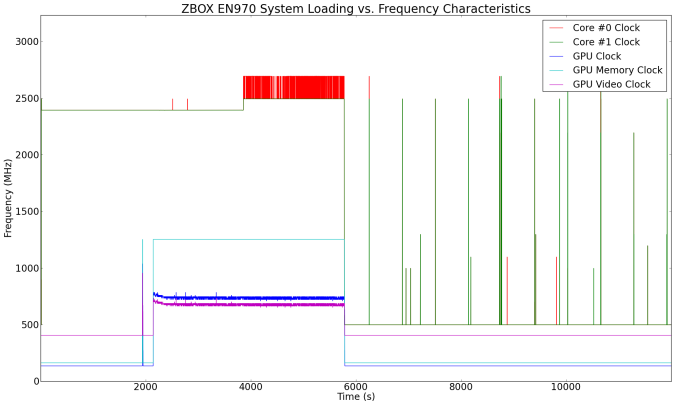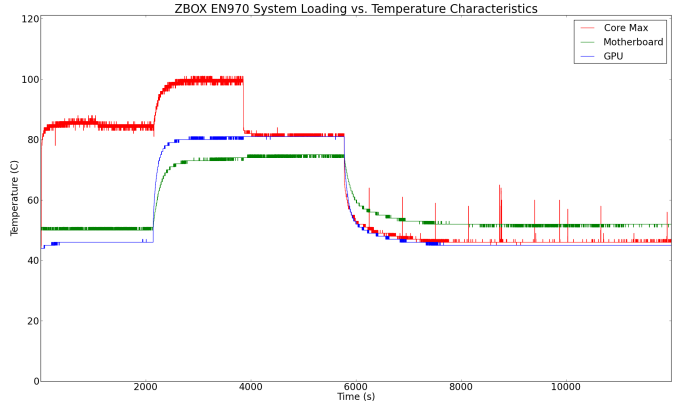Zotac ZBOX MAGNUS EN970 Review - A Gaming mini-PC Done Right
by Ganesh T S on September 28, 2015 8:00 AM ESTPower Consumption and Thermal Performance
The power consumption at the wall was measured with a 1080p display being driven through the HDMI port. In the graphs below, we compare the idle and load power of the Zotac ZBOX MAGNUS EN970 with other low power PCs evaluated before. For load power consumption, we ran Furmark 1.12.0 and Prime95 v27.9 together. Despite consuming close to 19W at idle, the ZBOX MAGNUS EN970 actually happens to be the PC with the lowest idle power amongst all the discrete GPU-equipped machines that we have evaluated so far.


The load power is also amongst the highest in the set of numbers that we have seen till now. However, the big separation between the idle and load powers indicate that the sytem can operate efficiently over a wide range of loading conditions.
Our thermal stress routine starts with the system at idle, followed by 30 minutes of pure CPU loading. This is followed by another 30 minutes of both CPU and GPU being loaded simultaneously. After this, the CPU load gets removed, allowing the GPU to be loaded alone for another 30 minutes. The various clocks in the system as well as the temperatures within the unit are presented below.
According to Intel's official specifications, the junction temperature of the Core i5-5200U is 105C. We find that pure CPU loading keeps the clock frequency half-way between the base frequency (2.2 GHz) and the maximum burst frequency (2.7 GHz). However, the temperature remains well below the junction temperature (around 82C). Getting the GPU into the equation ramps up the motherboard temperature as well as that of the GPU and GPU. However, the CPU remains below the junction temperature despite going up to as high as 102C. The GPU stabilizes around 81C.












88 Comments
View All Comments
KateH - Monday, September 28, 2015 - link
I would be very curious to hear more about the GPU rebranding situation... why would a 1280-shader GM204 on an MXM card be a 970m in a laptop but a 960 non-M in a SFF? Why would Nvidia/Zotac go to the trouble of editing the VGA BIOS and drivers to make this GM204 show up as a 960 when there are already loads of MXM 970m's that are functionally identical to this aside from re-badging? The OEM GPU re-branding situation is ridiculous; Zotac/Nvidia have created a doubly confusing situation where this card could be easily confused for either a significantly-slower GM107-based GTX 960m (that's itself a rebadged 860m) or a slightly-slower GM206 GTX 960 that has the potentially-important HEVC decode that's actually not present in this "960".KateH - Monday, September 28, 2015 - link
And while I'm on a rant, re-badging between generations is ridiculous too- but I know by now that's a losing battle that's only getting worse. FFS.mapesdhs - Monday, September 28, 2015 - link
A lot of that going on by all sides, but it's hard to discuss without enraging rival armies of haters and fanboys. We'd be a lot better off if nobody did it. What really bugs me is the massive performance overlap of newer lesser models vs. older models. The naming system allows one to infer that a newer card will have a particular level of basic performance, but the reality is often very different. I benchmarked a 650 Ti recently, was amazed to find it often failed to beat an old GTX 460.lmcd - Tuesday, September 29, 2015 - link
I mean the 650 Ti should be like 2/3 the power consumption at most, no?KateH - Tuesday, September 29, 2015 - link
Yeah, something like that. ~100-120W for a 650Ti vs ~150-170W for a 460. The 660 is in the same power envelope as the 460 and should outperform it by a fair marginrtho782 - Tuesday, September 29, 2015 - link
You're perfectly right. Having a separate mobile product stack made sense when mobile gpus were way behind desktop ones, now they use the same silicon, less so.I think we should have the same product names and tiers for both, perhaps use the "m" suffix in cases where the clockspeed is much lower in the laptop variant.
KateH - Tuesday, September 29, 2015 - link
I kinda wonder if it's not time to do away with the "M" suffix for GPUs altogether and move towards segmentation based on power, like what Intel has done with their K/S/H/Y/U suffixes. Low-power MXM/onboard GPUs are by no means strictly in the realm of notebooks anymore- AIO and SFF computers are using them more and more. And looking at AMD/NV's product stacks, "desktop" GPUs cover ~15W-250W (with all but the top-end being under ~150W) and "mobile" GPUs cover ~15W-125W- that's a whole lot of overlap.ruthan - Tuesday, September 29, 2015 - link
Better than Macmin, but otherwise is better build own, even if MXM is not possible to use by us second category people..adithyay328 - Thursday, October 1, 2015 - link
Those specs actually almost give my mid tower desktop a run for it's money-almost.aj654987 - Friday, October 2, 2015 - link
Well, for the alienware alpha with the 860m and the T series processors (Haswell 35W), the CPU's are almost all GPU limited, even the i3's. So there is room for a higher powered GPU.With going broadwell, the lowest desktop CPU is 65 watts so far, which is probably too high for that small case, so their only choice is a 15 watt mobile chip.